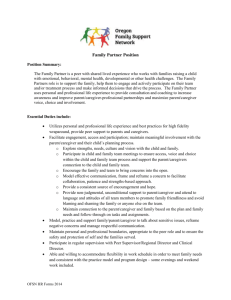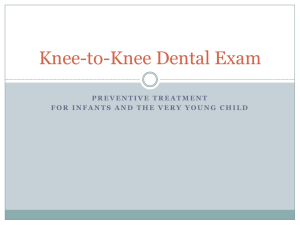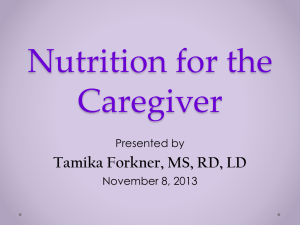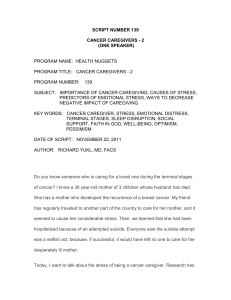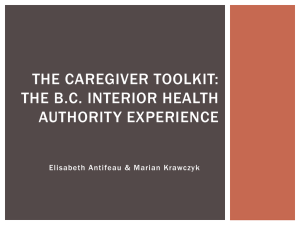ron case study info
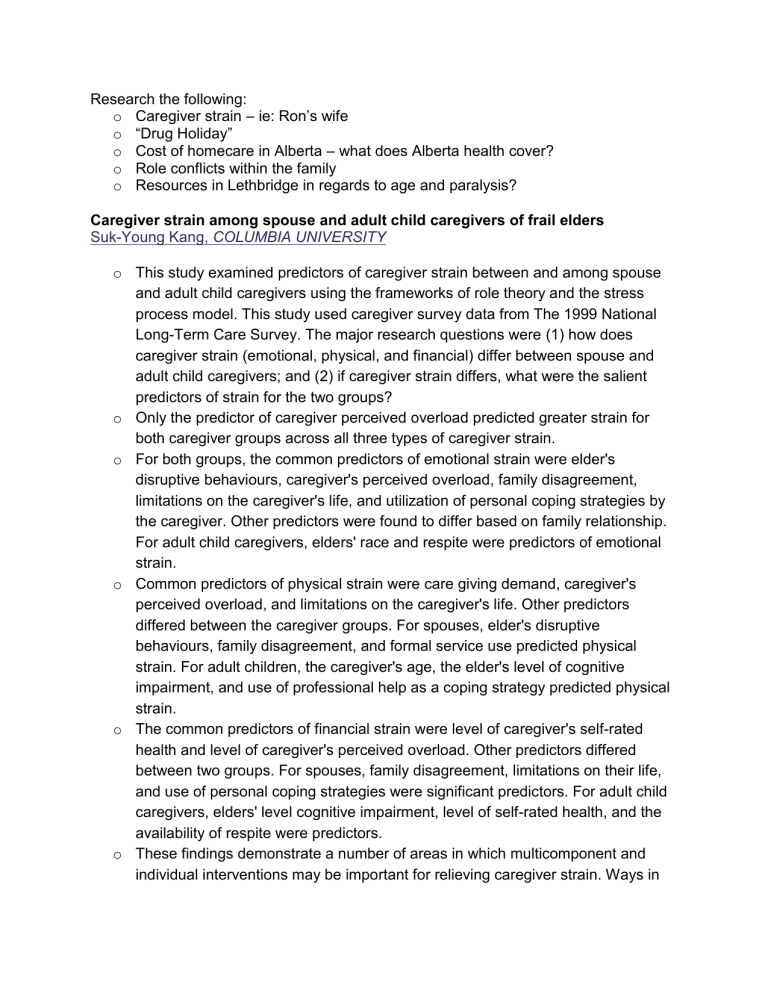
Research the following: o Caregiver strain – ie: Ron’s wife o “Drug Holiday” o Cost of homecare in Alberta
– what does Alberta health cover? o Role conflicts within the family o Resources in Lethbridge in regards to age and paralysis?
Caregiver strain among spouse and adult child caregivers of frail elders
Suk-Young Kang, COLUMBIA UNIVERSITY o This study examined predictors of caregiver strain between and among spouse and adult child caregivers using the frameworks of role theory and the stress process model. This study used caregiver survey data from The 1999 National
Long-Term Care Survey. The major research questions were (1) how does caregiver strain (emotional, physical, and financial) differ between spouse and adult child caregivers; and (2) if caregiver strain differs, what were the salient predictors of strain for the two groups? o Only the predictor of caregiver perceived overload predicted greater strain for both caregiver groups across all three types of caregiver strain. o For both groups, the common predictors of emotional strain were elder's disruptive behaviours, caregiver's perceived overload, family disagreement, limitations on the caregiver's life, and utilization of personal coping strategies by the caregiver. Other predictors were found to differ based on family relationship.
For adult child caregivers, elders' race and respite were predictors of emotional strain. o Common predictors of physical strain were care giving demand, caregiver's perceived overload, and limitations on the caregiver's life. Other predictors differed between the caregiver groups. For spouses, elder's disruptive behaviours, family disagreement, and formal service use predicted physical strain. For adult children, the caregiver's age, the elder's level of cognitive impairment, and use of professional help as a coping strategy predicted physical strain. o The common predictors of financial strain were level of caregiver's self-rated health and level of caregiver's perceived overload. Other predictors differed between two groups. For spouses, family disagreement, limitations on their life, and use of personal coping strategies were significant predictors. For adult child caregivers, elders' level cognitive impairment, level of self-rated health, and the availability of respite were predictors. o These findings demonstrate a number of areas in which multicomponent and individual interventions may be important for relieving caregiver strain. Ways in
which these predictors of caregiver strain can be used to design effective and efficient social work interventions are discussed. o Subject Area
SOCIAL WORK (0452); SOCIOLOGY, INDIVIDUAL AND FAMILY STUDIES
(0628) o It is generally recognized that caring for an elderly person with disabilities is, or can be, extremely stressful. The result is caregiver burnout, which may lead to actual physical or mental illness. Today, most caregivers are middle-aged grownup children or older spouses, caring for a parent or a spouse with disabilities. A recent study has examined the death rates for spousal caregivers, to see if they are at increased risk because of their undertaking. o Four communities in the USA supplied participants to this study. A caregiver was defined as someone whose spouse had difficulty with at least one of the recognized activities of daily living, or what is called an instrumental activity of daily living, due to physical health problems or mental confusion. A control group was made up of people whose spouses did not have any such disability. o At the time of enrolment, information on health was collected, and the participants were classified according to their health status. They were all asked to answer the question "how much of a mental or emotional strain is it on you to either provide the help directly, or to arrange for help to be provided for this activity?" Their responses divided them into three groups (1) those not helping a disabled spouse (2) those helping a disabled spouse but not experiencing care giving strain, and (3) those helping a disabled spouse but experiencing care giving strain. o Participants in the study were followed for an average of 4 1/2 years. Information on deaths among participants was obtained from obituaries, medical records, death certificates etc. o There were 392 caregivers and 427 non caregivers (controls) in the study. They were aged 66 to 96, with an average age of 80. Just over half of them were women. Out of those with spouses requiring care, 80% were providing care themselves, and 56% of these reported having "caregiver strain". A quarter of all caregivers had at least one existing disease at baseline, and another 40% had test results indicating a hidden (or subclinical) disease. o Four years after baseline, 103 (12.5%) of the participants had died. When compared with the control subjects -- i.e. those having spouses without any disability - and after adjustment for possible bias due to existing diseases, the likelihood of dying was 1.4 times greater in those not helping with their disabled spouse, and 1.1 times greater in those helping a disabled spouse but not reporting any strain with this. These results were not large enough to be considered significant. However, in the caregivers who were helping their disabled spouse but reporting strain associated with this activity, the likelihood of dying within 4 years was 1.6 times that of the control group. This was considered a significant increase in the risk of dying. o These results showed that being a caregiver and experiencing mental or emotional strain is indeed a risk factor for earlier death. It is probable that this
finding would be the same if the study had been conducted in middle-aged children caring for a disabled parent. The consequences are obvious. Firstly, caregivers who are suffering strain must be identified - this may not be easy (see
How To Spot Caregiver Burnout). Then, help for the caregiver must be provided.
Health care professionals are in the best position to ensure that such assistance is made available (see Help for Caregivers). In this way it may be possible to improve the outlook for the caregiver, who is indeed giving much, but is at increased risk to her or his own existence (Health and Age, 2008). o A drug holiday (sometimes also called a drug vacation , medication vacation , structured treatment interruption or strategic treatment interruption ) is when a patient stops taking a medication(s) for a period of time; anywhere from a few days to many months or even years if they feel it is in their best interests. o Planned drug holidays are used in numerous fields of medicine. They are perhaps best known in HIV therapy, after a study showed that stopping medication may stimulate the immune system to attack the virus. o Another reason for drug holidays is to permit a drug to regain effectiveness after a period of continuous use, and to reduce the tolerance effect that may require increased dosages. o In addition to drug holidays that are intended for therapeutic effect, they are sometimes used to reduce drug side effects so that patients may enjoy a more normal life for a period of time such as a weekend or holiday, or engage in a particular activity. For example, it is common for patients using SSRI antidepressant therapies to take a drug holiday to reduce or avoid side effects associated with sexual dysfunction o In the treatment of mental illness, a drug holiday may be part of a progression toward treatment cessation. The idea of a holiday is an acknowledgement that longer term psychoactive drug formulations may represent risks not apparent in early phases of use. The holiday is also a tool to assess a drugs benefits against unwanted side effects, assuming that both will end after an extended vacation (some psychoactive drugs have extended side effects long after cessation, however
Home care in ALBERTA
A. Responsibilities and Objectives
The mission of Alberta’s home care program is to give Albertans the opportunity to continue to live independently and in good health at home for as long as possible. Initially, only persons in need of professional health care as a result of a medical condition were eligible to participate in the program. Over time, the program was extended to persons requiring home support services and palliative care.
In Alberta, home care is managed by 17 Regional Health Authorities to which the provincial government has delegated responsibility for planning, day-to-day management and delivery of home care services. Specifically, the provincial Ministry of Health is responsible for developing policy directions, conducting research, establishing guidelines, and monitoring and evaluating programs and funding allocations. Each regional authority receives an overall budget based on a capitation formula. Funding by region takes into account various demographic and socioeconomic criteria, as well as the number of services one region provides to another. With respect to home care, the funding formula is also based on the province’s Home Care
Information System, which collates data on the type of services received and associated costs for each recipient.
The objectives of Alberta’s home care programs are as follows:
to prevent or reduce institutionalization;
to accelerate the release of patients from acute care facilities;
to assist persons with diminishing abilities to maintain a certain level of independence so that they can continue to live in their community;
to supplement the support provided by families or loved ones to persons with diminishing abilities;
to provide acute and palliative care at home.
B. Services
Each regional authority operates a “single window” access point that coordinates the delivery of short-term and long-term home care services. Regional authorities ensure delivery of general services related to:
planning and case management, evaluation and coordination;
management of professional services (nursing care, rehabilitative care, etc.);
management of short-term home support services;
management of human and financial resources.
The following services are provided to the public:
nursing care;
rehabilitative care (physiotherapy, occupational therapy, speech therapy, audiology services, social work, nutritional services and respiratory care);
services related to day-to-day activities (for example, help with dressing, personal hygiene, meal preparation and getting around inside and outside the home);
civic support services (for example, accompanying persons on outings, companion visits);
respite services for informal caregivers;
palliative care;
services related to routine household tasks;
medical supplies and devices furnished through the Alberta Aids to Daily Living
Program; supervised housing (“group homes”).
C. Delivery and Eligibility
1. Service Delivery
In Alberta, the vast majority of providers of professional services (such as nursing care, rehabilitative care and nutritional services) are employed by the regional authorities. However, some authorities contract out direct nursing care. Non-professional home care (support) services are delivered by private agencies, community organizations and volunteers. Eligible recipients may manage their own home support under the self-managed home care support program.
2. Eligibility
Home care in Alberta is subject to the following eligibility criteria:
proof of residence in the province;
assessment of care required prior to the delivery of any services;
lack or scarcity of informal caregivers to assist the prospective recipient;
suitability of the home for service delivery;
consent of the prospective recipient or of his/her legal representative;
interprovincial agreement in the case of residents living along the British
Columbia and Saskatchewan borders.
D. Service Coverage and Co-payment Charges
All Albertans are entitled to home care. Provincial program guidelines state that recipients must share in the cost of the services, but also that a person’s inability to pay for services must not prevent anyone from receiving the care required.
Coverage – professional services
Coverage – home support services
Co-payment charges
Home Care Costs:
Public Sector Coverage and Co-payment Charges
All professional services are available free of charge, although the range of services may vary from one authority to another, depending on the availability of resources.
Home support services may be obtained directly through the home care program or through the self-managed program, where clients are given a budget.
Home support services are subject to user fees based on the recipient’s income and the number of dependents. The ceiling on co-payment charges has been set at $300 per month. The hourly rate for housekeeping services is
$5, while meals cost $5 each.
Generally speaking, home care (professional and home support) costs must not exceed $3,000 per month.
With respect to medical supplies and devices (AADL), (7) recipients pay up to 25% of the costs to a maximum of $500 per year per family.
There is no cost to persons benefiting from an income support program, and low-income
earners may be entitled to financial aid.
Sources: Health Canada,
CARP’s Report Card on Home Care in Canada 2001
, web sites of various provincial ministries, and Library of Parliament.
E. Home Care Expenditures
1. Total Expenditures
For fiscal year 2000-2001, public spending on home care in Alberta was comparable to the national average. However, private sector spending was well below the national average, according to Health Canada estimates.
In Alberta, home care expenditures account for a modest share (2.87%) of overall spending on health care. In fact, only Prince Edward Island allocates a smaller share of its overall health care budget to home care.
Alberta
Total expenditures
(millions of dollars)
Per capita expenditures
(dollars)
All provinces
Total expenditures
(millions of dollars)
Per capita expenditures
(dollars)
Home Care Expenditures, 2000-2001
Public Sector
Expenditures
*
Private
Sector
Expenditures
Total
Expenditure s
Home Care as a
Percentage of Total Health Care
Expenditures (%)
260.4
86.89
2,690.9
87.51
29.5
9.85
764.3
24.86
289.9
96.74
3,455.2
112.37
2.87
—
3.54
—
* Provincial expenditures (excluding all federal spending under various programs)
Sources: Health Canada, Health Expenditures in Canada by Age and Sex, 1980-81 to 2000-01
– Statistical Annex
, August 2001; Library of Parliament, Parliamentary Research Branch, for certain calculations.
2. Expenditures by Age
In 2000, Alberta had the youngest population of any province in Canada: only 10.1% of
Albertans were 65 years of age or older. According to Statistics Canada, this figure should rise to 17.1% by the year 2021. This young population explains in part why per capita home care costs are below the national average.
The Alberta government covers approximately 90% of home care costs, while the private sector’s participation in the delivery of home care is only one-quarter of the level in Quebec.
This situation is somewhat paradoxical, since successive Alberta governments in recent decades have encouraged private sector involvement in this field.(8)
Home Care Expenditures by Age, 2000-2001
0-64 Years 65+ 85+ Total
Alberta
Total expenditures (millions of dollars) 95.5 194.4 74.2 289.9
Per capita expenditures (dollars)
Percentage of total health care expenditures allocated to home care (%)
35.42 645.43 2,320.28 96.74
1.52 5.11 7.47 2.87
Private sector expenditures as a percentage of total home care expenditures (%) 8.48 11.00 10.70 10.18
Sources: Health Canada, Health Expenditures in Canada by Age and Sex, 1980-81 to 2000-01
– Statistical Annex
, August 2001, and Library of Parliament.

